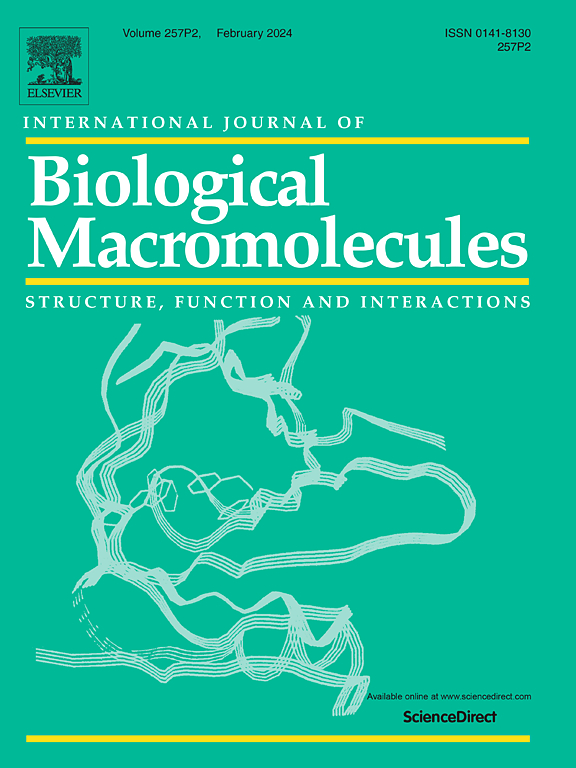Novel macromolecule CPD4 suppresses cell proliferation and metastasis of triple-negative breast cancer by targeting ROR1 protein
IF 7.7
1区 化学
Q1 BIOCHEMISTRY & MOLECULAR BIOLOGY
International Journal of Biological Macromolecules
Pub Date : 2025-04-23
DOI:10.1016/j.ijbiomac.2025.143301
引用次数: 0
Abstract
Breast cancer is the second most common cancer among women in the US, with triple-negative breast cancer (TNBC) accounting for 15–20 % of new diagnoses. TNBC cells lack estrogen and progesterone receptors, and human epidermal growth factor receptor 2, which makes them resistant to standard hormone treatments. Current therapies like chemotherapy and radiation often harm both cancerous and healthy cells, underscoring the need for developing new targeted treatments. ROR1, an oncoprotein that is overexpressed in various cancers, including breast cancer, is minimally present in normal tissues. Targeting ROR1 signaling has been shown to trigger apoptosis and reduce TNBC cell proliferation. A novel macromolecule compound, CPD4, was discovered through in-silico docking for its ability to bind and inhibit the pseudokinase domain of ROR1. In vitro evidence revealed that CPD4 decreases cell viability and induces apoptosis in TNBC cell lines at concentrations of 2–10 μM, while leaving normal breast cells unharmed. CPD4 also blocks migration, invasion, and causes G2/M-phase arrest in TNBC cells. Its mechanism of action involves reducing key downstream markers of ROR1 signaling, particularly the phosphorylation of AKT/GSK3β. In 3D spheroid cultures, CPD4 reduces the size of TNBC spheroids. Moreover, the combination treatment of CPD4 and the standard chemotherapy docetaxel exhibits synergistic efficacy against different TNBC cell lines with a combination index below 0.01. These results suggest that CPD4 holds promise as a therapeutic option for TNBC and could potentially benefit other cancers with ROR1 overexpression.
新型大分子CPD4通过靶向ROR1蛋白抑制三阴性乳腺癌细胞增殖和转移
乳腺癌是美国女性中第二大常见癌症,三阴性乳腺癌(TNBC)占新诊断的15 - 20%。TNBC细胞缺乏雌激素和孕激素受体,以及人类表皮生长因子受体2,这使得它们对标准激素治疗有抵抗力。目前的治疗方法,如化疗和放疗,往往会损害癌细胞和健康细胞,这凸显了开发新的靶向治疗方法的必要性。ROR1是一种在包括乳腺癌在内的各种癌症中过度表达的癌蛋白,在正常组织中很少存在。靶向ROR1信号已被证明可触发细胞凋亡并减少TNBC细胞增殖。通过硅对接发现了一种新的大分子化合物CPD4,它能够结合和抑制ROR1的假激酶结构域。体外实验表明,CPD4在2 ~ 10 μM浓度下可降低TNBC细胞系的细胞活力,诱导细胞凋亡,而对正常乳腺细胞无损伤。CPD4还阻断TNBC细胞的迁移、侵袭并导致G2/ m期阻滞。其作用机制涉及降低ROR1信号的关键下游标记物,特别是AKT/GSK3β的磷酸化。在三维球体培养中,CPD4可减小TNBC球体的大小。此外,CPD4与标准化疗多西他赛联合治疗对不同TNBC细胞系具有协同作用,联合指数均在0.01以下。这些结果表明,CPD4有望作为TNBC的治疗选择,并可能潜在地有益于其他ROR1过表达的癌症。
本文章由计算机程序翻译,如有差异,请以英文原文为准。
求助全文
约1分钟内获得全文
求助全文
来源期刊
CiteScore
13.70
自引率
9.80%
发文量
2728
审稿时长
64 days
期刊介绍:
The International Journal of Biological Macromolecules is a well-established international journal dedicated to research on the chemical and biological aspects of natural macromolecules. Focusing on proteins, macromolecular carbohydrates, glycoproteins, proteoglycans, lignins, biological poly-acids, and nucleic acids, the journal presents the latest findings in molecular structure, properties, biological activities, interactions, modifications, and functional properties. Papers must offer new and novel insights, encompassing related model systems, structural conformational studies, theoretical developments, and analytical techniques. Each paper is required to primarily focus on at least one named biological macromolecule, reflected in the title, abstract, and text.

 求助内容:
求助内容: 应助结果提醒方式:
应助结果提醒方式:


